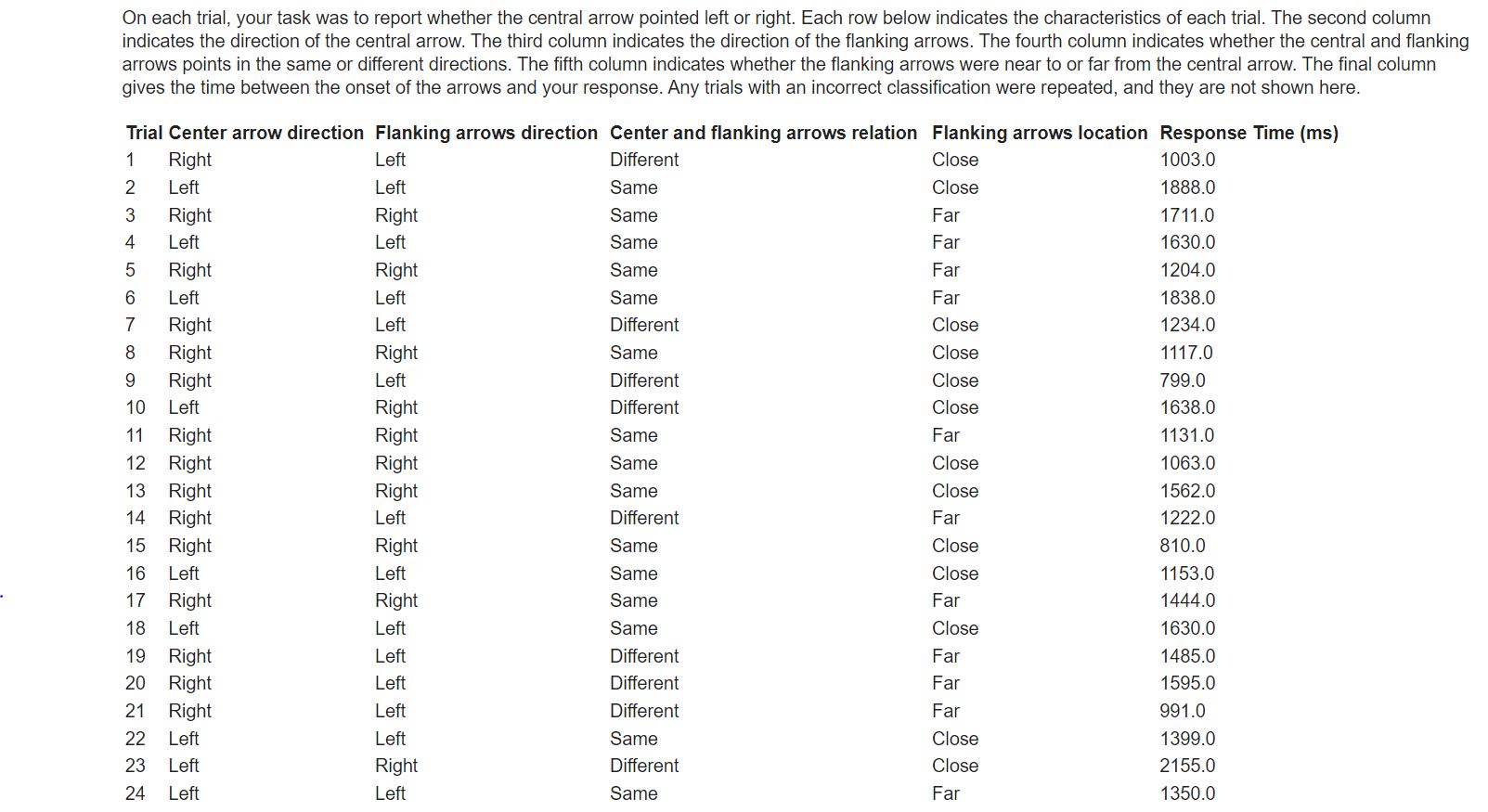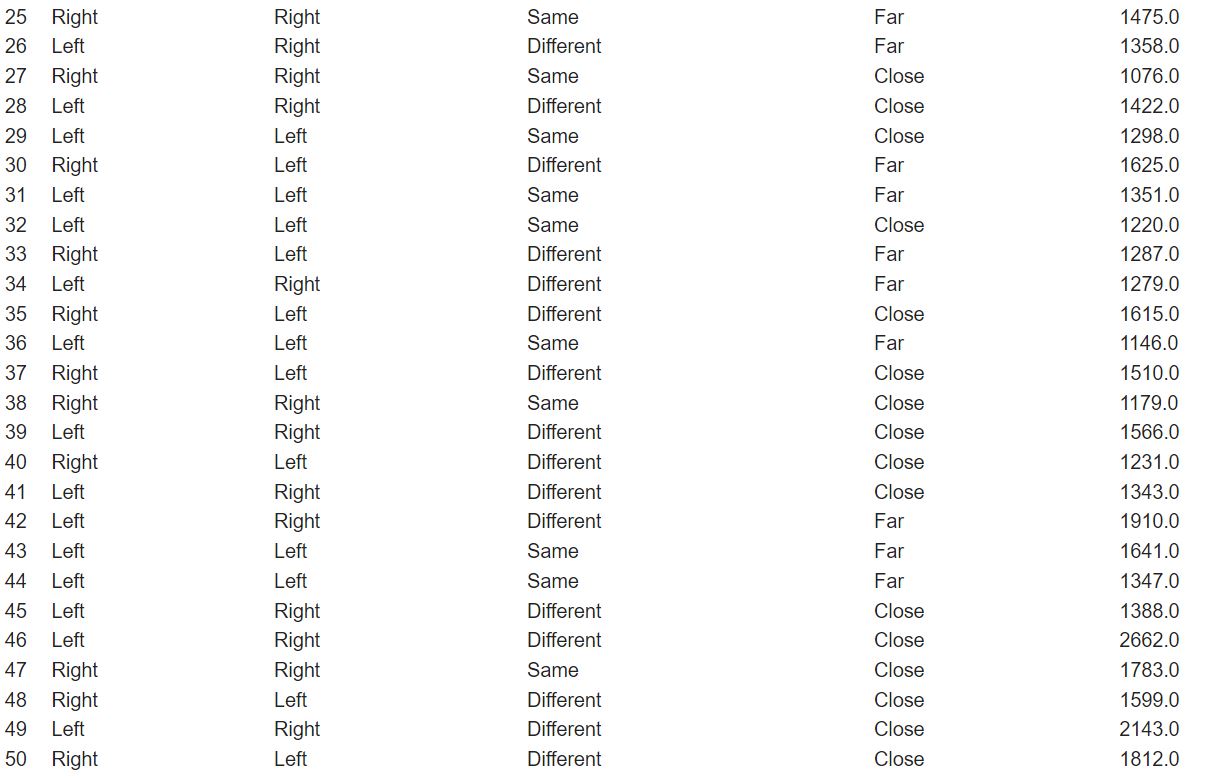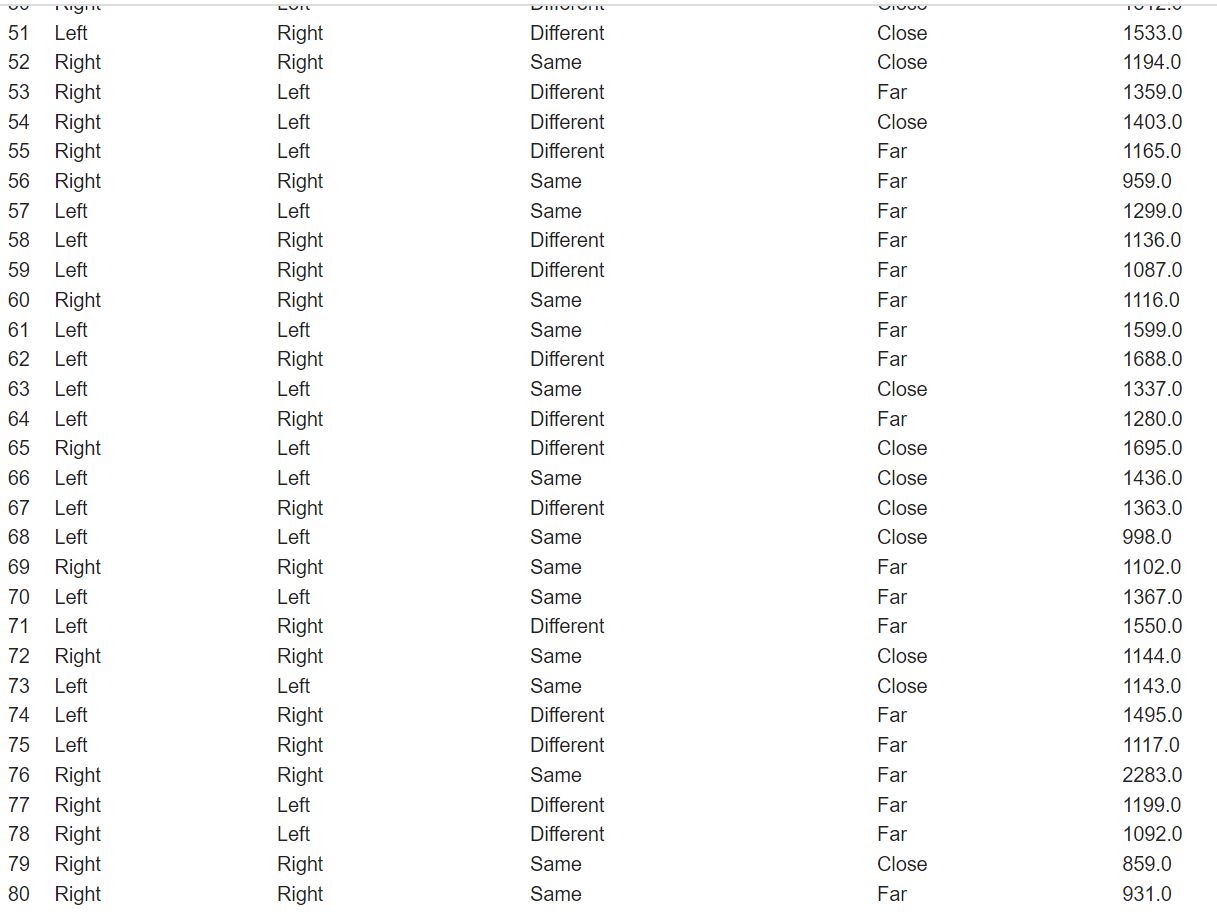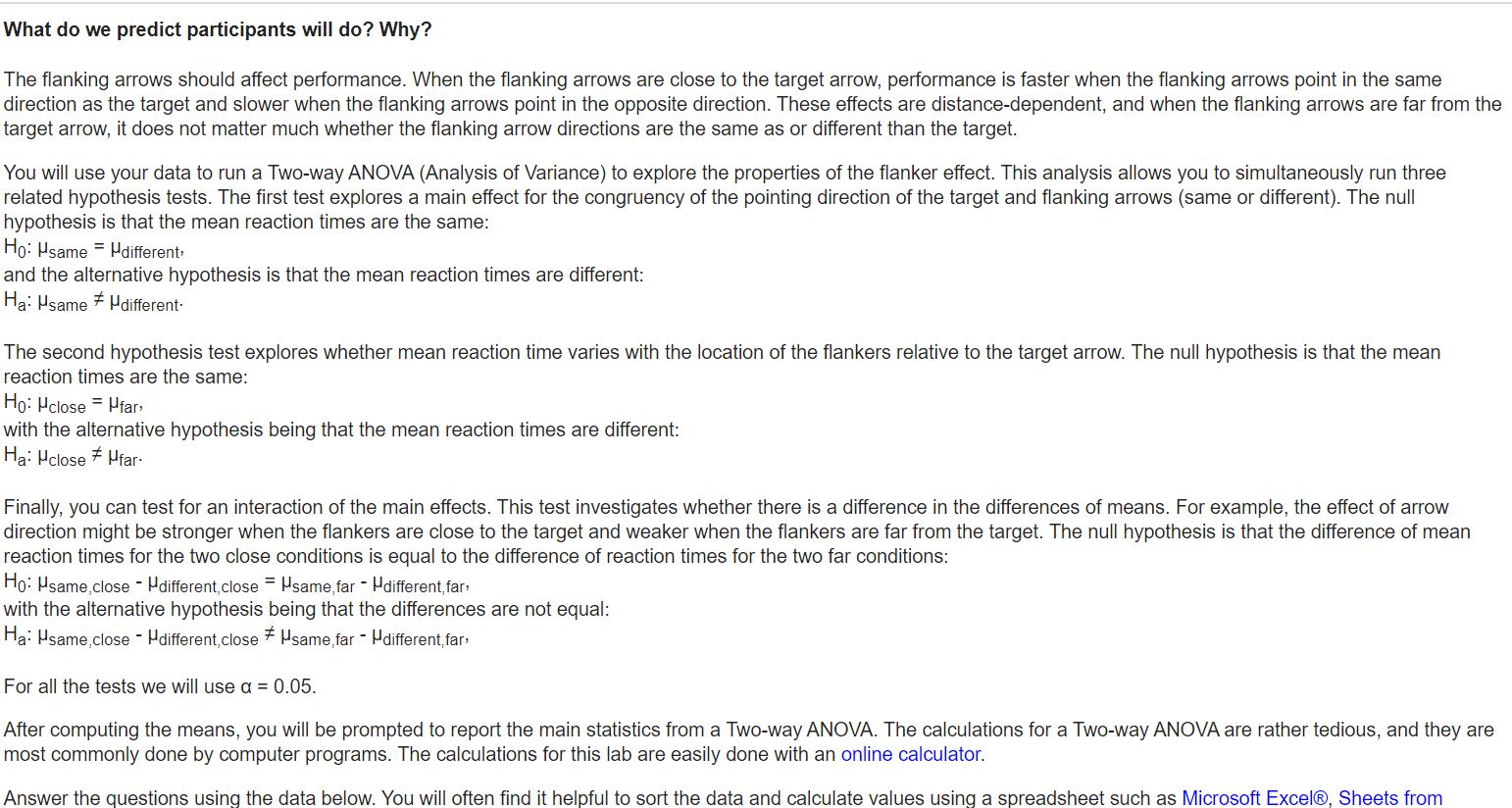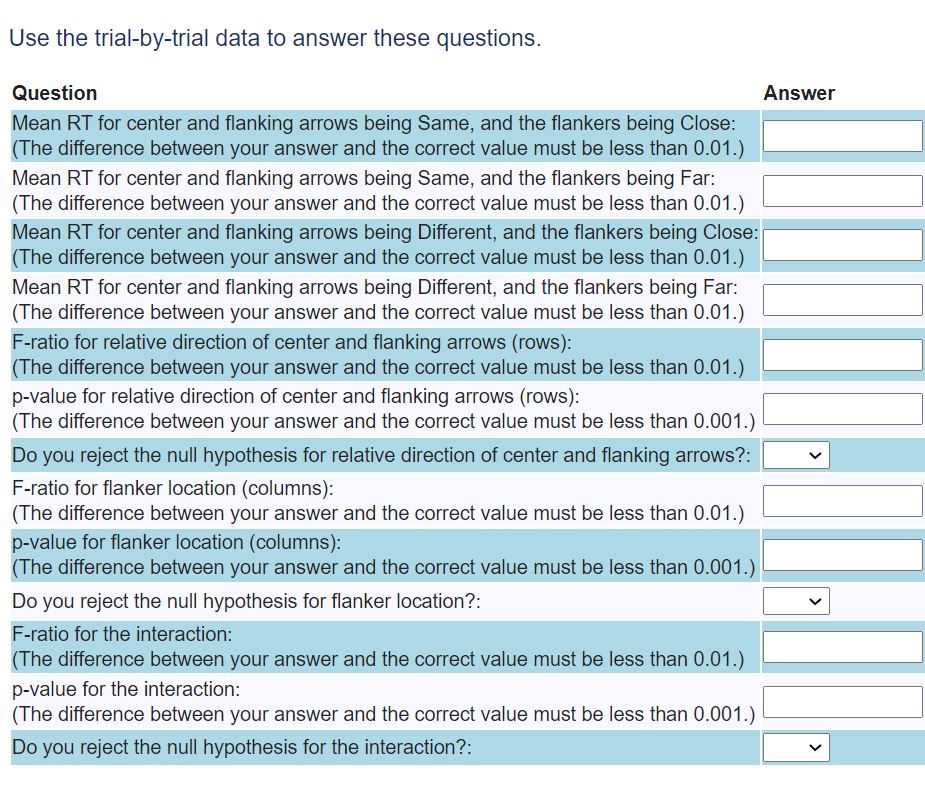Hello tutors! I have this question on Flanker Effect. I have included the Data, questions, and instructions. Your help is appreciated!!!
On each trial, your task was to report whether the central arrow pointed left or right. Each row below indicates the characteristics of each trial. The second column indicates the direction of the central arrow. The third column indicates the direction of the anking arrows. The fourth column indicates whether the central and flanking arrows points in the same or different directions. The fth column indicates whether the anking arrows were near to or far from the central arrow. The nal column gives the time between the onset of the arrows and your response. Any trials with an incorrect classification were repeated, and they are not shown here. Trial Center arrow direction Flanking arrows direction Center and flanking arrows relation Flanking arrows location Response Time (ms) 1 Right Left Different Close 1003.0 2 Left Left Same Close 1 888.0 3 Right Right Same Far 1711.0 4 Left Left Same Far 1630.0 5 Right Right Same Far 1204.0 6 Left Left Same Far 1 838.0 7 Right Left Different Close 1234.0 8 Right Right Same Close 1111.0 9 Right Left Different Close 799.0 10 Left Right Different Close 1638.0 11 Right Right Same Far 1131.0 12 Right Right Same Close 1063.0 13 Right Right Same Close 1562.0 14 Right Left Different Far 1222.0 15 Right Right Same Close 810.0 1 6 Left Left Same Close 1 153.0 17 Right Right Same Far 1444.0 18 Left Left Same Close 1630.0 19 Right Left Different Far 1485.0 20 Right Left Different Far 1595.0 21 Right Left Different Far 991.0 22 Left Left Same Close 1 399.0 23 Left Right Different Close 2155.0 24 Left Left Same Far 1350.0 25 Right Right Same Far 1475.0 26 Left Right Different Far 1358.0 27 Right Right Same Close 1076.0 28 Left Right Different Close 1422.0 29 Left Left Same Close 1298.0 30 Right Left Different Far 1625.0 31 Left Left Same Far 1351.0 32 Left Left Same Close 1220.0 33 Right Left Different Far 1287.0 34 Left Right Different Far 1279.0 35 Right Left Different Close 1615.0 36 Left Left Same Far 1146.0 37 Right Left Different Close 1510.0 38 Right Right Same Close 1179.0 39 Left Right Different Close 1566.0 40 Right Left Different Close 1231.0 41 Left Right Different Close 1343.0 42 Left Right Different Far 1910.0 43 Left Left Same Far 1641.0 44 Left Left Same Far 1347.0 45 Left Right Different Close 1388.0 46 Left Right Different Close 2662.0 47 Right Right Same Close 1783.0 48 Right Left Different Close 1599.0 49 Left Right Different Close 2143.0 50 Right Left Different Close 1812.0uu 51 52 53 54 55 56 57 58 59 60 61 62 63 64 65 66 67 68 69 70 71 72 73 74 75 76 77 78 79 80 I \"an; Left Right Right Right Right Right Left Left Left Right Left Left Left Left Right Left Left Left Right Left Left Right Left Left Left Right Right Right Right Right Right Right Left Left Left Right Left Right Right Right Left Right Left Right Left Left Right Left Right Left Right Right Left Right Right Right Left Left Right Right .uu..u What do we predict participants will do? Why? The anking arrows should affect performance. When the anking arrows are close to the target arrow, performance is faster when the anking arrows point in the same direction as the target and slower when the anking arrows point in the opposite direction. These effects are distance-dependent, and when the anking arrows are far from the target arrow, it does not matter much whether the anking arrow directions are the same as or different than the target. You will use your data to run a Two-way ANOVA (Analysis of Variance) to explore the properties of the anker effect. This analysis allows you to simultaneously run three related hypothesis tests. The rst test explores a main effect for the congruency of the pointing direction of the target and anking arrows (same or different). The null hypothesis is that the mean reaction times are the same: H0: \"same = \"different: and the alternative hypothesis is that the mean reaction times are different: Ha: \"same \"different- The second hypothesis test explores whether mean reaction time varies with the location of the ankers relative to the target arrow. The null hypothesis is that the mean reaction times are the same: H0: \"close = \"far: with the alternative hypothesis being that the mean reaction times are different: Ha: \"close \"far- Finally, you can test for an interaction of the main effects. This test investigates whether there is a difference in the differences of means. For example, the effect of arrow direction might be stronger when the ankers are close to the target and weaker when the ankers are far from the target. The null hypothesis is that the difference of mean reaction times for the two close conditions is equal to the difference of reaction times for the two far conditions: H03 l-'same,close ' \"differentclose = l-'same,far ' l-'different,farv with the alternative hypothesis being that the differences are not equal: Ha: l-'same,close ' \"differentclose # \"samefar ' \"differentfar: For all the tests we will use a = 0.05. After computing the means, you will be prompted to report the main statistics from a Two-way ANOVA. The calculations for a Two-way ANOVA are rather tedious, and they are most commonly done by computer programs. The calculations for this lab are easily done with an online calculator. Answer the questions using the data below. You will often nd it helpful to sort the data and calculate values using a spreadsheet such as Microsoft Excel, Sheets from Use the trial-bytrial data to answer these questions. Question Answer Mean RT for center and flanking arrows being Same, and the ankers being Far: (The difference between your answer and the correct value must be less than 0.01.) :' Mean RT for center and anking arrows being Different, and the ankers being Far: S (The difference between your'answer and the correct value must be less than 0.01.) p-value for relative direction of center and anking arrows (rows): (The difference between your answer and the correct value must be less than 0.001.) S Fratio for flanker location (columns): (The difference between your answer and the correct value must be less than 0.01.) S Do you reject the null hypothesis for anker location?: p-value for the interaction: S (The difference between your answer and the correct value must be less than 0.001..) _
